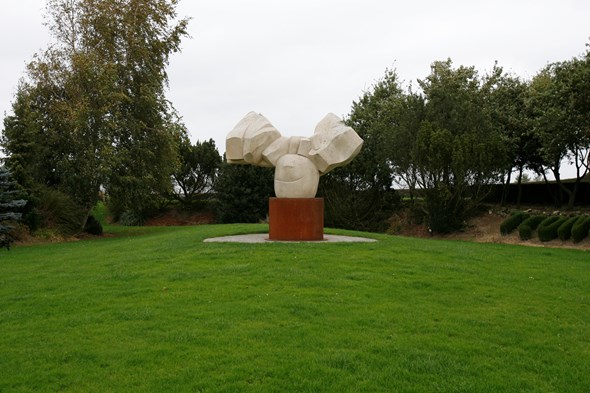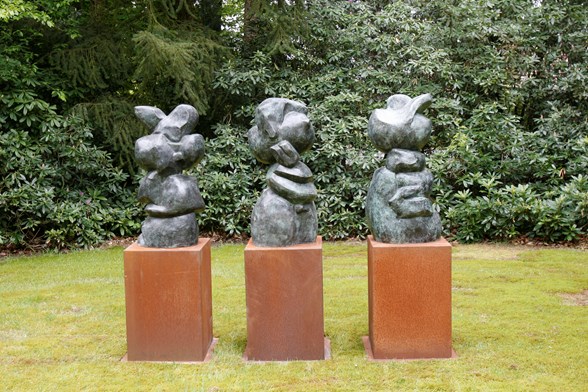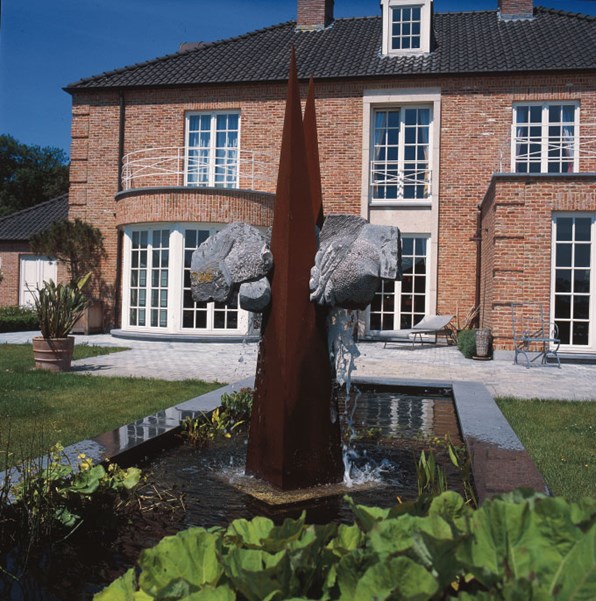
Belgian Sculptor Luc Ledene has been gathering a reputation as an artist to watch. His works play with form and matter, capturing something of humanity in their intricate curves and protrusions. ArtDependence caught up with Ledene to find out more about the ways he approaches the pieces he makes and the reasons he began creating sculptural pieces.
Image courtesy for Luc Ledene
Belgian Sculptor Luc Ledene has been gathering a reputation as an artist to watch. His works play with form and matter, capturing something of humanity in their intricate curves and protrusions.
ArtDependence caught up with Ledene to find out more about the ways he approaches the pieces he makes and the reasons he began creating sculptural pieces.
ArtDependence (AD): When did you first start making art?
Luc Ledene (LL): After my education in carpentry. At the age of 16 I went to study interior architecture in Mechelen.
I never intended to make art, but while I was there I got struck by the possibility of creating three-dimensional statues in wood. I started evening school in woodcarving and made my first creations in wood.

Image courtesy for Luc Ledene
After my studies in Mechelen, I went to study sculptural arts at the Sint-Lucas institute in Ghent. Driven by my curiosity for new techniques I worked in clay, plaster and polyester and made my first figurative sculptures in natural stone. Thanks to several figurative assignments (portraits, giants etc) and the support of art lovers who built up a collection over time, I was able to make artwork in a way that felt free and unbound without having to engage with the commercial circuit, art fairs or the gallery business.
AD: How did you come to sculpture as a medium?
LL: I was most passionate about matter and the technique of sculpting. I’ve always drawn and painted and I’m convinced that this is a necessary basis for the things I do, but I have profiled myself as a sculptor. A sculpture to me is a three-dimensional interplay of lines and volume on which you as the sculptor can create a magic tension in all directions. That’s why I like sculpting the most. Drawings and paintings lack volume, but you can still create an exciting interplay of lines. I display both my sculptures and my paintings and drawings in my own art studio at my home.
AD: What is the starting point for the works you make?
LL: All the works I make are a translation of my feelings for matter. These feelings finds their base in the figurative formal relationship between women (round) and men (angular), which creates a tension in matter and the entire sculpture. I find it very important that the composition of the forms creates that exact tension that translates, without words, the feelings I have towards the sculpture.

Image courtesy for Luc Ledene
That’s why I never give titles to my work. I am convinced that feelings speak for themselves. To me, a title influences the observers in a negative way: I think it can only restrict or mislead their feelings.
AD: When you begin a new project, what are your first steps?
LL: To answer your question I make a difference between the artwork I make for me and the work I make on behalf of a client.
‘My personal projects’ start with me choosing the stones in the stone quarries. Followed by several drawings and designs - and possibly some paintings. After this process I leave everything I made behind me. I take the stone, look at it, and let my feelings do the rest. Every action I take creates a new form, a new tension in the material. I keep on making it better regarding my feelings until the tension answers these feelings. At that moment the finishing works follow. Sometimes I’m stuck and when no improvement makes the tension meet my feelings, I put the piece aside. Sometimes for more than 10 years. Until all of a sudden I get back to work on that piece and I can create the right tension to finish it. My work and my feelings about it must satisfy me entirely. If it doesn’t, I put it aside.
For projects I work on on behalf of a client, I start by listening. I judge their ideas in respect to the feelings I have for the matter in order to obtain a perfect result. In most of these projects the client decides what material we will use (bronze, stone, steel etc) and the location to put the sculpture once it is finished. Outside of that, they tend to leave me to do what I feel is best.

Image courtesy for Luc Ledene
For me, it’s very important to be able to do all the steps myself from the very beginning of a sculpture until the final placement: going to the quarry to choose the stone myself, making the sculpture (sculpting, cutting, carving, grinding, finishing), transportation and final placement.
AD: What influences have most shaped your work?
LL: I’ve worked a lot according to living models. I tend to distil ideas down from there. I mainly use the interplay of lines of torsos to create tension in my sculptures. This evolution of organic design and abstraction is the most fascinating part of my work.
Even after all these years, sculpting remains a fascinating interplay between matter, technique and most importantly feelings based on the composition of organic forms. For me, it feels like breeding/magic.
AD: Can you tell us more about the monumental fountains you have created for the Eandis building?
LL: The fountain for Eandis in Ieper was an exceptional assignment. It gave me complete freedom to create a monumental sculpture dedicated to energy. In dialogue with the client, the complete freedom I got as an artist resulted in a monumental artistic attraction, a landmark/beacon for the company along a busy road.

Image courtesy for Luc Ledene
This design of the fountain consists of a circular pond with 7 needles carrying organic elementary forms in bluestone and supported by impelling water. The seven needles (magic number) nurture the central turning 6-meter high cone. This turning cone caries a big bronze sculpture patinated green and supported by a colossal water fountain.
The theme of the assignment was ‘energy’ so the sculpture is named ‘the source of energy’.
These kinds of commissions give me a sublime freedom to transform my emotional world into a monumental architectural work. It was a process in which I took every step myself, from the very first drawings until the final placement in Ieper.
AD: How does your work differ if you are creating a piece for indoor rather than creating a piece for outdoors?
LL: The difference between indoor and outdoor artwork is mainly found in the material: some types of stone are not frost-resistant, so not suitable for outdoor applications. Others are. To me, sculptures are a combination of matter, technique and feeling, so matter does play a leading role!
When an artwork is intended for outdoor use, it must be able to withstand the natural elements. This is an aspect that does not affect indoor artwork. It is very important to listen to the wishes of the client in order to build up a relationship of trust (and possible friendship) and to be able to create a piece of art that satisfies everyone’s wishes.
AD: What projects are you currently working on?
LL: Currently, I’m mainly occupied with sculpting my own art works until a monumental opportunity presents itself again.
AD:Which current artists are you excited by?
LL: Here on my island in the plains, I'm not really involved with other contemporary artists, but I feel supported by the monumentality and purification of the form of the works of Henry Moore, Richard Serra and Constantin Brâncuși. Of course, as in every piece of artwork, the scenery in which I work and live plays an important role.

ArtDependence Magazine is an international magazine covering all spheres of contemporary art, as well as modern and classical art.
ArtDependence features the latest art news, highlighting interviews with today’s most influential artists, galleries, curators, collectors, fair directors and individuals at the axis of the arts.
The magazine also covers series of articles and reviews on critical art events, new publications and other foremost happenings in the art world.
If you would like to submit events or editorial content to ArtDependence Magazine, please feel free to reach the magazine via the contact page.